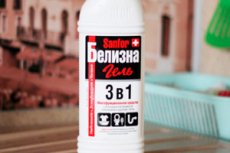Medical expert of the article
New publications
Whitewash vapor poisoning
Last reviewed: 29.06.2025

All iLive content is medically reviewed or fact checked to ensure as much factual accuracy as possible.
We have strict sourcing guidelines and only link to reputable media sites, academic research institutions and, whenever possible, medically peer reviewed studies. Note that the numbers in parentheses ([1], [2], etc.) are clickable links to these studies.
If you feel that any of our content is inaccurate, out-of-date, or otherwise questionable, please select it and press Ctrl + Enter.

Belizna is a popular disinfectant. The active component of the preparation is chlorine. Its amount is about 95% of the total mass of sodium hypochlorite. That is, the chemical composition of the cleaning agent has a suffocating effect for a living organism. Inhalation of whitewash leads to damage to both internal and external mucous membranes.
Whitewash vapor poisoning most often occurs in people who, due to their activities, are forced to come into contact with this substance. In this case, the damage to the body can have both acute and chronic symptoms.
Symptoms of the whitewash poisoning
The main signs of intoxication include:
- Cough (dry, attack-like).
- Progressive diseases (of various etiologies) of the respiratory tract.
- Dizziness and recurrent headaches.
- Nausea and vomiting.
- Seizures.
- Muscle weakness.
Symptoms of poisoning can come in several forms:
- Mild - burning eyes, excessive lacrimation, sneezing, and a sore throat. Unpleasant symptoms disappear within 24 hours and leave no consequences or complications.
- Medium - the symptomatology of the mild form is supplemented by constant attacks of dry cough, a feeling of compression in the chest and throat. Possible pulmonary edema.
- Severe - the above symptoms plus respiratory distress. The victim may experience respiratory arrest, both short-term and life-threatening.
In some cases, the disease becomes lightning fast. Convulsions, involuntary urination and defecation, and vein swelling in the upper part of the body develop. In most cases, such a condition ends in death. If the whitewash got into the respiratory tract in large quantities, then death occurs within 30 minutes. But most often the victims are diagnosed with a mild and medium degree of damage.
Treatment of the whitewash poisoning
At the first signs of chlorine poisoning, an ambulance should be called immediately. Before the ambulance arrives, the victim should be taken out into fresh air and forced to take deep breaths by mouth. It is also necessary to remove all constricting clothing. If a person is unconscious, but the pulse and breathing are not disturbed, then he is given a sniff of ammonia to bring him to consciousness. In other cases, indirect cardiac massage and artificial respiration are indicated. Further treatment is handled by physicians. If the pathology is left to its own devices, there is a risk of lung inflammation, emphysema and more serious complications.
Specialized treatment in a medical facility may include the following:
- Flushing the Poisoned Area: One of the first steps in treating bleach poisoning is to flush the poisoned area with plenty of water. This helps dilute and remove the chemicals from the surface of the skin and mucous membranes.
- Observation and monitoring of condition: The victim will be closely monitored with specialized medical devices to assess their condition, including respiratory status, pulse, blood pressure and blood oxygen levels.
- Treatment of complications: If complications develop, such as skin or respiratory burns, appropriate treatment measures will be taken, including the use of topical anesthetics, antibiotics, or oxygen therapy.
- Use of antidotes: In some cases, special antidotes or antidotes may be required to neutralize the effects of the poisonous substances contained in the whitewash.
Atropine is commonly used as an antidote for whitewash poisoning.
Atropine is an antagonist of acetylcholine that blocks its action on muscarinic receptors. In bleach poisoning, atropine is used to counteract side effects caused by overstimulation of muscarinic receptors, such as excessive heart rate, increased gastrointestinal secretion, and increased salivary gland secretion.
The dosage and methods of administration of atropine can be determined by a physician depending on the severity of the patient's condition and the nature of the poisoning. Atropine is usually administered intravenously under the supervision of medical personnel.
- Detoxification: Depending on the chemical composition of the whitewash and the degree of poisoning, detoxification procedures such as administering drugs to bind poisonous substances or performing blood purification procedures such as hemodialysis may be used.
- Maintenance of vital functions: It is important to ensure that the casualty maintains vital bodily functions throughout treatment and care.

